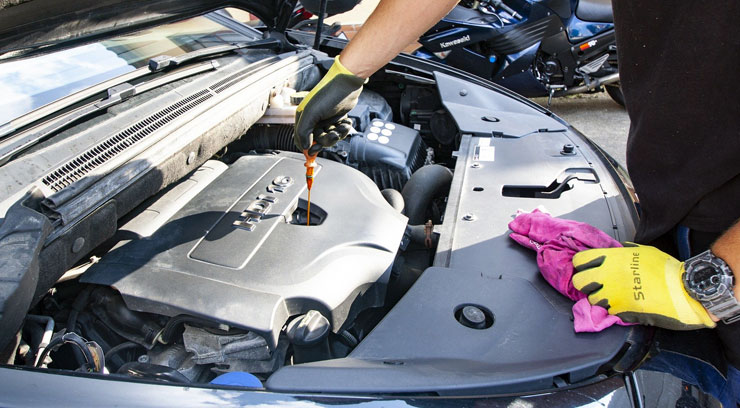Why do cars burn oil?

Soon after buying a car, either new or used, there are certain elements that every owner must consider: insurance, fuel and maintenance. While other things can nibble off pieces of your annual car budget, these three elements generally make up the lion’s share of car ownership expenditures.
Unless your new car is a lemon, generally, used cars will need more frequent and extensive repairs than new ones, especially if they’re well past the 100,000-mile mark. One of the most common issues with older cars, as miles add up, is burning oil. If your car is losing oil and there doesn’t seem to be any oil marks beneath the car on the ground, it’s likely that your car is burning oil. Here is why that happens and what you can do about it.
Main signs of oil burning
With modern cars relying on hundreds and in some cases thousands of sensors, there is a general feeling among owners that they don’t need to check under the hood unless a light comes on, or some weird sound starts making its way into the cabin. And, since the vast majority of repairs and maintenance operations can only be performed in auto shops, it’s hard to blame the owners anyways.
Still, one of the best ways to check if your car is burning oil is to simply check the oil level once in a while. It is advisable that, the older a car gets, the more often the oil level should be checked. Doing it once a month should save you and your car from a costly repair due to running a dry sump and causing severe engine damage.
Even if you haven’t checked the oil level in a while, there are other ways of knowing when a car is eating oil as a side dish to the gasoline or diesel.
For one, when engine oil burns, the exhaust fumes have a particular odor. Even if your nose can’t quite distinguish the smell of burnt oil from regular exhaust gases, you will definitely notice the color.
When your car’s engine is burning oil, exhaust fumes are no longer transparent, and tend to turn into a blue shade. Start your car and leave it running for a few seconds, pull the parking brake and check the exhaust. If there’s blue smoke coming out, check your oil levels immediately and find your way to a trusty auto shop for expert analysis.

Performance may diminish when your engine is burning oil. In more modern cars, there are various sensors that alter the air-fuel mixture according to the content of the exhaust gases. When oil is being burnt by the engine, the concentration of various particles in the exhaust gas will change, and lambda sensors will pick on it, consequently altering the air fuel mixture. In many cases, there will be a slight loss in power in the mid to high RPM ranges, as well as an increase in fuel consumption, when oil is being burnt by the engine.
Finally, always pay attention to the trusty oil light. Usually, there are two stages of an oil level light in any car. When the oil level drops below minimum, the check oil level light turns bright yellow. This is your first warning to get to the nearest auto shop for a checkup. If the oil light turns red, stop the car immediately. While oil burning rarely consumes all the engine oil quickly, a red oil level indicator means any further activity of the engine will likely lead to irreversible damage. At this point, you should either call road assistance or tow the car to a local trusted auto shop.
New cars may burn oil too
While older cars tend to burn oil due to wear and tear, more recent vehicles also have a tendency to do the same. Usually, in the case of older vehicles, worn seals or gaskets are the primary reason why engine oil finds its way into the combustion chamber and gets burnt alongside fuel. Other reasons for oil burning include clogged crankcase ventilation systems, wrong oil type or low-quality oil, defective piston rings or high oil pressure.
Surprisingly, it’s not just the old vehicles burning oil, but also some of the newer models. According to various statistics, car manufacturers almost eradicated the issue of oil burning during the mid-2000s. However, the issues started appearing again after early 2010s, around the time that more stringent regulations on emissions and fuel consumption were passed.
So, one explanation why modern cars may burn oil regards the need for meeting regulations. In order to make cars more efficient, automakers tend to push the limits of the engines, squeezing more power out of the same components. More horsepower means more stress, and consequently higher wear level.
In some cases, such as the twin-turbocharged 4.4-liter BMW engine with a long-term 10,000-mile service interval, oil burning could have become so bad that the engine would dry up the sump before the next maintenance interval. Don’t even think about getting a 2015-18 Shelby GT350 Mustang without an extended warranty due to its high risk of oil consumption, oil starvation and engine failure.

How much oil does a car normally burn?
While burning gallons of oil every 10,000 miles is anything but normal with any car engine, in some conditions, it is expected that some cars will start burning oil at a certain point in their lifespan.
If in the first years of a car’s lifespan, any oil burning event should be reported to the dealer and have it fixed under warranty, as time goes by, cars tend to start burning small amounts of oil. According to communities around the internet, Acura, Audi and Subaru owners reported the highest amounts of oil burning in the first 5 years of their car’s lifetime, especially on turbocharged engines.
To better explain, the reports showed that between 11% and 28% of the owners revealed they added at least a quart of oil into the engine between oil changes. The highest number of reports concerned the Audi 3-liter V6 supercharged engine, with almost 48% of owners reporting adding more than a quart of oil between oil changes.
Fixing and preventing oil burning
Burning oil is bad news, especially when in high amounts. Like with any other problem, prevention is best as it’s more time effective and usually cheaper than fixing. As such, simple preventive measures can help diagnose oil burning early on and reduce the repair costs on your car.
Make a habit of regularly checking oil levels using the dipstick. Do it once a week, with a cold engine. Cold start the car, then get out and check if any blue smoke is coming out of the exhaust, indicating oil burning.
Finally, make a habit of checking beneath the car for any oil dripping, as well as the lower engine area. It’s a good idea to have regular professional check-ups on the car, having a mechanic inspect usual areas for oil leaking into the combustion chamber.




















































